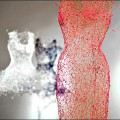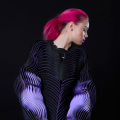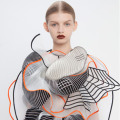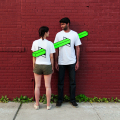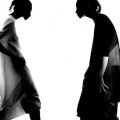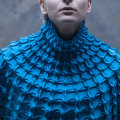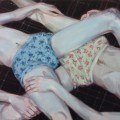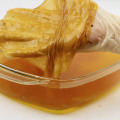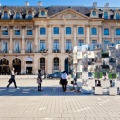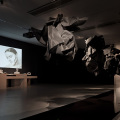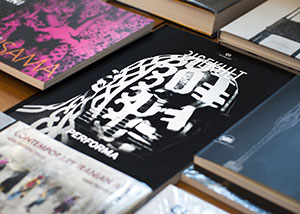Watching a piece of leather transition through a rainbow spectrum of color before your eyes would sound, to most, like the opening premise of a blockbuster sci-fi flick. But this is no optical illusion. It is a garment coated in ink that responds to the slightest environmental change, more closely mimicking the gradients of infrared thermography than the meager, stilted efforts of a dime store mood ring. Lauren Bowker, co-founder and lead materials chemist of The Unseen, is the sorceress behind this transformational, technicolor fabric. This is just one piece in her arsenal of mind-blowing material advancements that she one day hopes to apply to everything, from medical devices, to air pollution detection, to color-changing handbags. Bowker is changing the concept of fabric and its limitations, one ornately constructed garment at a time. She is resistant to define her collective’s research and experimentations as a part of the wearable technology movement. When one looks at contemporaries in her field, it’s easy to see why. The work The Unseen produces is of a completely different ilk—more radically refined and smartly applied than the fitness wristbands and sweat-wicking shirts that flood the market under the guise of forward-thinking innovation. There is a touch of magic and mystery to everything they create, an effect only heightened by their live demonstrations and totemic, vaguely occult, imagery and sense of design. These scientific developments, compelling enough on their own, are only heightened by the collective’s deep appreciation for nature, which they, in turn, seek to enhance by way of otherworldly materials. An amalgamation of chemistry, artistry, and design, The Unseen demonstrate that the future rests in seamless integration to produce spellbinding results that translate the intangible into the terrestrial. Your garments are quite intricate and very precise. Can you tell me a little bit more about the design process and the timeline of creation for each piece? I started working on this particular ink over a year ago when I was working as a consultant for a Formula 1 team. We were working to create an ink to visualize the airflow around the car so they could build a computer program to design the car into a better shape. I came away from that and thought, Well, what would the aerodynamics look like around a human? So I tailored the ink back down to be able to respond to the friction around a human. Then, it was a case of working out the designs and what they should look like. We didn’t necessarily want them to be aerodynamic shapes, we wanted to create trips that made the airflow around the human look aesthetically interesting, so we designed based off that. We looked at a lot of armor and a lot of different kinds of unit-based things that are then multiplied to create a sculpture. So, an individual thing [replicated] many times over and how you could create a natural, organic shape out of that. Then they were all hand-cut and hand-sewn together here with us. What helped you realize that these very different worlds of fashion and science fit together so well? I’m not sure if they do fit together so well. When you merge technology into a garment, I don’t think it has too much aesthetic appeal. For me, wearable technology is much more about the material itself. If you go into any sort of high street brand, even Mark & Spencer, you can see some of the most technically advanced fabrics in the world—you’ve got the shirt that doesn’t need to be ironed, the kind of anti-microbial shirts that only need a certain amount of washing per week, polyester in and of itself is a huge technical development. We want to highlight the fact that material technology is way more advanced in certain areas than some of the integrated electronics that people are using today. We’re trying to find an aesthetic way for technology to be seen differently in that light and combined with fashion. But for us, it’s not necessarily fashion, we just like working with the environment and the way a human adapts to the environment. So, it always becomes a wearable piece, but we’re not necessarily ever going to create a ready-to-wear collection out of this. It’s more about changing the way people see material and see product, not so much about selling a mass-manufactured version of it. I think that’s also why people are so drawn to your designs, they heighten the way we take this technology and incorporate it into something that’s both aesthetically beautiful and functional, as opposed to,Oh, here’s the technology, and it’s jammed in there and it doesn’t seem to quite work. Exactly. I was in a meeting this morning and the client was asking what they have to give me in order to make another version of my designs, and I said I don’t need anything other than data. We’re really a data visualization company in a material exploration house. We just want to show people data and the stuff going on around us that you don’t normally see. That unseen world around the human and how the human interacts with and disrupts their environment. We want to show people that, rather than just creating a game or a sort of interface out of it. It’s more about doing it poetically, like nature has always done. What’s a piece of scientific technology you’re working on or looking to incorporate into your upcoming designs?At the moment, the “Air” collection is very responsive to the natural environment, and to the stress around it. Over the next six months, we have a research and development phase in laundering these inks and getting them to a point where they can be implemented onto vast amounts of surfaces and have passed all the sort of rules and regulations that an ink should. Going forward, we’ll also be looking at the digital linkup of this technology. In other words, material that’s not only being controlled by the environment, but how that would look if it began to be digitally controlled. How did you become interested in working with inks specifically? I call it ink. Half the time, it actually isn’t an ink, it just seems to be the first thing that comes off my tongue. My background was in chemistry and then I worked up in Manchester to create an ink that absorbs air pollution and changes color from yellow to black to tell you how much pollution you’ve had in your system each day. I presented that scientifically for a long time but got a bit bored of being in the research world. So I went back to the Royal College of Art to do textiles and study the combination of linking up technology and chemicals to something a bit more beautiful: what would it look like if we could create these materials that sense and do things? That brought me into a consultancy period in which I worked for loads of different clients as a material specialist, creating new materials that respond to the environment. It might be changing color, it might be changing shape. It’s a surface technique that does a certain thing. What we’ve shown so far in The Unseen is just the color change, but hopefully, we’ll go on to show the wealth of materials we have under our belt that don’t just change color, but do all sorts of things. We only launched as The Unseen six months ago, we’re just hoping every fashion season we can come up with new ways to impress people’s conception of material. Could you tell me a little about your involvement with and experience at the Wearable Futures conference? I was picked as one of the Futures Ten to create a piece. Wonder was the theme, so I did a little winged feather piece, which, when you breathed over it, fluctuated in color. It changed from blue to red to green. Then we did a presentation on the “Magic” panel with a magician and Dr. Raymond Oliver, a great nano-technologist, whom I’d worked with at the Royal Academy of Engineering. We sat on the panel to discuss the future of wearables from a magic angle and the future of why my work, for example, was seen differently than some of the other technologies around. Are there any design innovations that you’ve seen lately that have inspired you? I’m not sure it’s ever designers for me. I work with a great guy all the time, Ryan Hopkinson, who’s a brilliant videographer and filmmaker. He’s creating new processes and new technologies so he can create what he sees in his head in real life and document it with the camera. I’m always interested in the process behind things, not necessarily the final product. I’m interested in people like Man Ray, I love his process, he developed a process to capture, if that makes sense. I’m not sure there’s anyone I look to for inspiration now in terms of product. I like to look at process, anyone from Tim Burton to Stephen Hawking. You’ve mentioned an interest in partnering with the medical community to create designs. What do you want to execute in that field? I want there to be a universal color code for the healthcare system. For example, the NHS loses £996 million a year on early admissions, just due to asthma attacks. So, the money loss there is predominately due to parents giving the medication to their asthmatic sons or daughters early when they don’t yet need to, and then bringing them into hospitals when actually they’re not going to have an asthma attack, they just need a rest. So, we should have some sort of universal system or fabric, color, really, which could be implemented across various devices, be it a scarf, a watch face, a mobile phone. It would monitor your skin conductivity and your blood oxygen level and would let you know what stage of asthma attack you were going to have. Similarly, what stage of heart attack you were going to have. You would know whether you need to rest, call an ambulance, or get to the hospital immediately—or whether it’s too late and you’re a goner. [It could be] some sort of an early indication system to prevent the waste of medication and money. That’s also something that seems like, once it was put into place, could easily be applied down through the medical system. Absolutely, and this type of technology can exist. I’ve worked for U.K. Sport and a lot of athletic companies who have the money to do this. That’s not the issue, the issue is mass manufacturing it. Same with all wearable technologies, the issue is putting it into a mass-manufacturing process. With electronics, half the time you have to create a new manufacturing process. The cost of that versus the cost of what already exists, in terms of medicine, at least, is a no-go until someone makes the manufacturing process cheaper and it trends through the big brands like Apple. With The Unseen and the inks and the different concoctions that we create, we’re lucky that we can put our technologies into existing manufacturing processes. We don’t have the strain of having to come up with a whole new process if we wanted to mass manufacture. The NHS obviously doesn’t have the funding for things like that, but hopefully, by doing the bigger scale collaborations with bigger corporations that do have the money, we can create something that’s affordable for the NHS, or for medical industries in the future. I was reading about some of your past collaborations, and I read that you were recently approached by Will.I.Am to make uniforms for the Olympics, is that true? Last year, yeah, but I’m not allowed to talk about it. No, of course not, but can you talk about what you want to work on in the future in terms of collaborations? Yeah, we’ve got a lot coming out over the next six months. Obviously, we’ll do the collection at fashion week next September, but in the meantime, we have a big collaboration with Swarovski, which will come out in Fast Company in two, three months. Then we’ve got a couple of more entities, one from the sporting industry, one from the car industry, one from the interiors industry, and one from a luxury leather company, which we’ll be releasing products for in September. I’m not allowed to say who they are. We’re not short on collaboration, shall we say. Is that something you’ve always wanted, is that how you imagined The Unseen to be? We’re lucky in that we have a system where everyone kind of sees their own application for it and those applications can be so different that we can have different clients and not step on each other’s toes. It’s nice to build the brand up working with people like that. But we’ll only work with the people we believe are right for our brand’s aesthetic and that we believe have got that magic themselves. We don’t just want to have everything up every shirt and skirt in the world. It’s more about doing something special. A lot of it might just stay in research, we don’t know yet, we’ll see over the next six months how things develop. What is your WILD Wish? My WILD Wish would be for everyone to just shut up about wearable technology.
Lauren Bowker: See the UnseenVIDEOVideo link:Ink and materials that change colour according to climate by Lauren Bowker from Dezeen on Vimeo. COMMENTSRELATED POST |
|
|
|
|

























